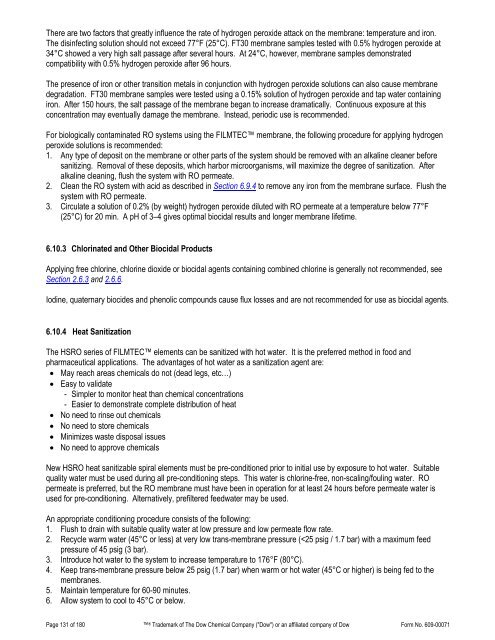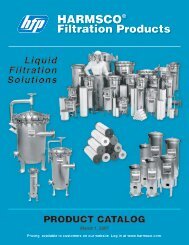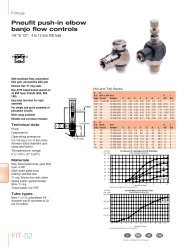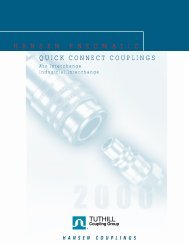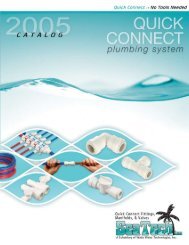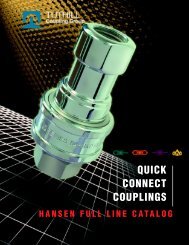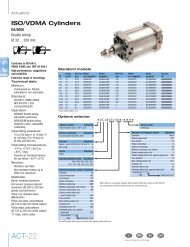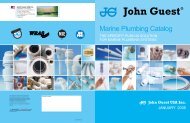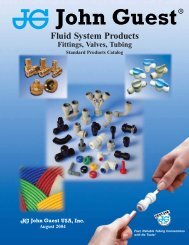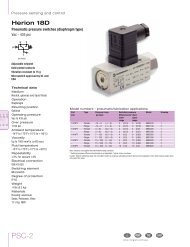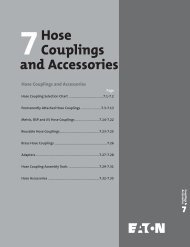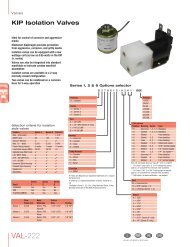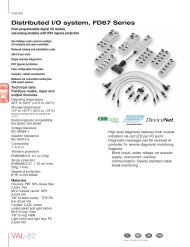Additional InformationBy experience, the cleaning solution of Na 4 EDTA with caustic has been found to be slightly less effective than a standardcaustic solution or a solution of caustic and Na-DDS.For any solution, contact time is critical. Several overnight soaks may be necessary to restore the system performance.After the elements are clean it is very beneficial to clean one additional time to clean off the last remaining biofilm layer onthe surface of the membrane. Any remaining biofilm will tend to attract and trap dirt, so an extra cleaning will increase thetime between cleanings. In the event of severe biofouling, slug dosing of a biocide may be required to enhance the results ofthe cleaning procedure. Please refer to Section 2.6.5 for details regarding biocide usage.When biofouling is an operational problem, regular sanitization procedures as described in Section 6.10 are recommendedafter cleaning.6.9.7 Emergency CleaningWhen cleaning has not been carried out in time, e.g., the differential pressure (ΔP) has already doubled, or the normalizedproduct flow has dropped by 50%, the success of the previously described cleaning processes may be limited. If thosestandard cleaning techniques fail to remove the foulants, more harsh cleaning methods can be tried.Please contact your Dow representative for recommendations. It has to be stressed, however, that no warranty can be givenon the efficiency of any cleaning, nor on the membrane performance after such cleaning attempts.6.10 Sanitizing RO/NF Membrane Systems6.10.1 IntroductionThe sanitization of RO/NF membrane systems as described in this chapter is the application of biocidally effective solutionsor hot water to the membranes while the system is offline, i.e. not in production mode. The online dosage of biocidalchemicals while the system is in production mode is dealt with in Section 2.6, Biological Fouling Prevention.Membrane systems are sanitized in order to keep the number of living microorganisms at an acceptably low level. There aretwo main reasons why sanitization is required:a) Smooth operation. Microorganisms may grow into a biofilm at the membrane and feed spacer surface and causebiofouling. Biofouling is a major threat to system operation, and regular sanitization is part of a strategy to controlbiofouling. Regular sanitization helps to keep the level of biological growth low enough to avoid operational problems.In RO systems operating with biologically active feed water, a biofilm can appear within 3–5 days after inoculation withviable organisms. Consequently, the most common frequency of sanitization is every 3–5 days during peak biologicalactivity (summer) and about every 7 days during low biological activity (winter). The optimal frequency for sanitizationwill be site-specific and must be determined by the operating characteristics of the RO system.b) Permeate water quality. Some applications, for example in food and pharmaceutical industries, require a high productwater quality with respect to microbiological parameters. Although RO and NF membranes are theoretically rejecting100% of microorganisms, any minute leakage in the membrane system may allow the permeate water to getcontaminated. The risk of contamination is much higher with a biofilm present on the feed side; therefore the membranehas to be kept in a sanitary state. Regular sanitizations in these applications are required to ensure the microbiologicalquality of the permeate water, even if no operational problems are encountered.6.10.2 Hydrogen Peroxide and Peracetic AcidHydrogen peroxide or a mixture of hydrogen peroxide and peracetic acid has been used successfully for treating biologicallycontaminated reverse osmosis and nanofiltration systems that use FILMTEC membranes. Commercially availablehydrogen peroxide/peracetic acid solutions come in a concentrated form and are diluted with RO/NF permeate to obtain a0.2% (by weight) peroxide solution.Page 130 of 180 ® Trademark of The Dow Chemical <strong>Company</strong> ("Dow") or an affiliated company of Dow Form No. 609-00071
There are two factors that greatly influence the rate of hydrogen peroxide attack on the membrane: temperature and iron.The disinfecting solution should not exceed 77°F (25°C). FT30 membrane samples tested with 0.5% hydrogen peroxide at34°C showed a very high salt passage after several hours. At 24°C, however, membrane samples demonstratedcompatibility with 0.5% hydrogen peroxide after 96 hours.The presence of iron or other transition metals in conjunction with hydrogen peroxide solutions can also cause membranedegradation. FT30 membrane samples were tested using a 0.15% solution of hydrogen peroxide and tap water containingiron. After 150 hours, the salt passage of the membrane began to increase dramatically. Continuous exposure at thisconcentration may eventually damage the membrane. Instead, periodic use is recommended.For biologically contaminated RO systems using the FILMTEC membrane, the following procedure for applying hydrogenperoxide solutions is recommended:1. Any type of deposit on the membrane or other parts of the system should be removed with an alkaline cleaner beforesanitizing. Removal of these deposits, which harbor microorganisms, will maximize the degree of sanitization. Afteralkaline cleaning, flush the system with RO permeate.2. Clean the RO system with acid as described in Section 6.9.4 to remove any iron from the membrane surface. Flush thesystem with RO permeate.3. Circulate a solution of 0.2% (by weight) hydrogen peroxide diluted with RO permeate at a temperature below 77°F(25°C) for 20 min. A pH of 3–4 gives optimal biocidal results and longer membrane lifetime.6.10.3 Chlorinated and Other Biocidal ProductsApplying free chlorine, chlorine dioxide or biocidal agents containing combined chlorine is generally not recommended, seeSection 2.6.3 and 2.6.6.Iodine, quaternary biocides and phenolic compounds cause flux losses and are not recommended for use as biocidal agents.6.10.4 Heat SanitizationThe HSRO series of FILMTEC elements can be sanitized with hot water. It is the preferred method in food andpharmaceutical applications. The advantages of hot water as a sanitization agent are:• May reach areas chemicals do not (dead legs, etc…)• Easy to validate- Simpler to monitor heat than chemical concentrations- Easier to demonstrate complete distribution of heat• No need to rinse out chemicals• No need to store chemicals• Minimizes waste disposal issues• No need to approve chemicalsNew HSRO heat sanitizable spiral elements must be pre-conditioned prior to initial use by exposure to hot water. Suitablequality water must be used during all pre-conditioning steps. This water is chlorine-free, non-scaling/fouling water. ROpermeate is preferred, but the RO membrane must have been in operation for at least 24 hours before permeate water isused for pre-conditioning. Alternatively, prefiltered feedwater may be used.An appropriate conditioning procedure consists of the following:1. Flush to drain with suitable quality water at low pressure and low permeate flow rate.2. Recycle warm water (45°C or less) at very low trans-membrane pressure (
- Page 1 and 2:
DowWater SolutionsFILMTEC Reverse O
- Page 3:
2.6 Biological Fouling Prevention .
- Page 7 and 8:
1. Basics of Reverse Osmosis and Na
- Page 9 and 10:
Nanofiltration (NF)Nanofiltration r
- Page 11 and 12:
How to Use Reverse Osmosis and Nano
- Page 13 and 14:
1.4 Membrane DescriptionThe FILMTEC
- Page 15 and 16:
Membrane systems are typically desi
- Page 17 and 18:
1.8 Element CharacteristicsFILMTEC
- Page 19 and 20:
2. Water Chemistry and Pretreatment
- Page 21 and 22:
SeawaterSeawater with TDS of 35,000
- Page 23 and 24:
Table 2.5 Water analysis for RO/NFS
- Page 25 and 26:
Table 2.7 Solubility products of sp
- Page 27 and 28:
In this process, only Ca 2+ , Ba 2+
- Page 29 and 30:
For the concentration ranges presen
- Page 31 and 32:
The conditions for CaCO 3 scale con
- Page 33 and 34:
Figure 2.3 Langelier saturation ind
- Page 35 and 36:
These computations have been descri
- Page 37 and 38:
Figure 2.5 “K” versus ionic str
- Page 39 and 40:
Figure 2.6 Ksp for CaSO 4 versus io
- Page 41 and 42:
2.4.6 Calcium Fluoride Scale Preven
- Page 43 and 44:
Figure 2.8 K sp for SrSO 4 versus i
- Page 45 and 46:
2.4.7 Silica Scale PreventionDissol
- Page 47 and 48:
Table 2.10 Solubility of SiO 2 vers
- Page 49 and 50:
2.4.8 Calcium Phosphate Scale Preve
- Page 51 and 52:
Table 2.9 Various fouling indicesIn
- Page 53 and 54:
Frequent shutdowns and start-ups sh
- Page 55 and 56:
If the differential pressure across
- Page 57 and 58:
1. Intake (surface) or well, before
- Page 59 and 60:
or combined residual chlorine (CRC)
- Page 61 and 62:
2.6.5 DBNPADBNPA (2,2, dibromo-3-ni
- Page 63 and 64:
2.6.11 Use of Fouling Resistant Mem
- Page 65 and 66:
2.11 Treatment of Feedwater Contain
- Page 67 and 68:
2.13 Summary of Pretreatment Option
- Page 69 and 70:
26. Handbook of Industrial Membrane
- Page 71 and 72:
Table 3.1 System design information
- Page 73 and 74:
3.2 Batch vs. Continuous ProcessAn
- Page 75 and 76:
3.4 Single-Stage SystemIn a single-
- Page 77 and 78:
The apparent salt passage of the sy
- Page 79 and 80: Instead of having a separate high-p
- Page 81 and 82: 3.9.1 Membrane System Design Guidel
- Page 83 and 84: In Table 3.6, the small commercial
- Page 85 and 86: Table 3.8 Number of stages of a sea
- Page 87 and 88: 3.11 System Performance Projection3
- Page 89 and 90: 3.11.2 Design Equations and Paramet
- Page 91 and 92: Table 3.10 Design equations for pro
- Page 93 and 94: 3.11.3 Comparing Actual Performance
- Page 95 and 96: The high-pressure concentrate is fe
- Page 97 and 98: If the product water from an RO sys
- Page 99 and 100: Besides the above recommendations,
- Page 101 and 102: 4. Loading of Pressure VesselsThis
- Page 103 and 104: The process of shimming is performe
- Page 105 and 106: 4.5.2 Summary of Large Element Inte
- Page 107 and 108: 5. System Operation5.1 Introduction
- Page 109 and 110: 5.2.3 Start-Up SequenceProper start
- Page 111 and 112: 5.2.4 Membrane Start-Up Performance
- Page 113 and 114: 5.5.3 SeawaterIn principle, the ope
- Page 115 and 116: Table 5.1 Reverse osmosis operating
- Page 117 and 118: A. Normalized Permeate FlowQS=ΔPsP
- Page 119 and 120: For the operating conditions we hav
- Page 121 and 122: 4. During recirculation of cleaning
- Page 123 and 124: 2. The cleaning pump should be size
- Page 125 and 126: 6.7 Effect of pH on Foulant Removal
- Page 127 and 128: Cleaning ProcedureThere are seven s
- Page 129: If the organic fouling is the resul
- Page 133 and 134: 7. Handling, Preservation and Stora
- Page 135 and 136: 7.4 Preservation of RO and NF Syste
- Page 137 and 138: If the normalized actual performanc
- Page 139 and 140: 8.3.3 Localization of High Solute P
- Page 141 and 142: Figure 8.2 Permeate probing apparat
- Page 143 and 144: 8.4.5 Performance TestThe standard
- Page 145 and 146: 8.5.1.1 Low Flow and Normal Solute
- Page 147 and 148: . Metal Oxide FoulingMetal oxide fo
- Page 149 and 150: . Organic FoulingThe adsorption of
- Page 151 and 152: 8.5.3 High Pressure DropHigh differ
- Page 153 and 154: In case of fullfit or heat sanitiza
- Page 155 and 156: Breakpoint chlorinationBreak tankBr
- Page 157 and 158: FeedThe input solution to a treatme
- Page 159 and 160: Milligram per litre (mg/L)Mixed-bed
- Page 161 and 162: SBS Sodium bisulfite, NaHSO 3.Scale
- Page 163 and 164: 9.2 Specific Conductance of Sodium
- Page 165 and 166: Figure 9.1 Conductivity of ionic so
- Page 167 and 168: 9.6 Temperature Correction FactorTa
- Page 169 and 170: 9.9 Osmotic Pressure of Sodium Chlo
- Page 171 and 172: Details - TestEquipment andSpecific
- Page 173 and 174: satisfactory for such a determinati
- Page 175 and 176: case for almost all tested biocides
- Page 177 and 178: 9.12 Key Word IndexAbrasion - 150 B
- Page 179 and 180: Positive displacement pump - 95 Shu


